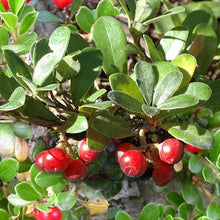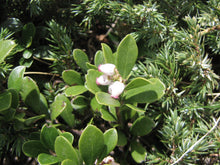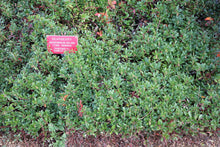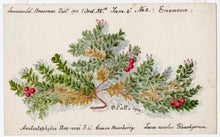Kinnikinik
Regular price
$5.00
Sale
Arctostaphylos uva-ursi
Origin: Alberta
Improvement status: Wild
Seeds per packet: ~40
BOTANICAL SAMPLE - NOT GERMINATION TESTED
Life cycle: Perennial
Kinnikinik, or red bearberry, is an extremely winter-hardy (to Zone 2) creeping evergreen sub-shrub in the heather family with edible red berries and pretty blueberry-like flowers. Its shiny leaves have been smoked traditionally as an alternative to tobacco.
The Lady Bird Johnson Wildflower Center in Texas has a great write-up on this plant which we'll reproduce here:
"Red bearberry is a trailing, evergreen shrub with paddle-shaped leaves on flexible branches. The thick, leathery leaves, rolled under at the edges, are yellow-green in spring, dark-green in summer, and reddish-purple in the fall. Nodding clusters of small, bell-shaped, pink or white flowers occur on bright-red stems. Flowers in racemes on short branches. Bright-red berries succeed the flowers and persist into winter. This ground-trailing shrub has the papery, reddish, exfoliating bark typical of woody plants in northern climates. It is frequently seen as a ground cover in sandy areas such as the New Jersey pine barrens. It is very common on Cape Cod, where it covers vast areas in open, sandy, pine-studded communities. Its complete range is the largest of any in its genus, and it is the only Arctostaphylos species to occur outside of North America, ranging across northern Eurasia and across northern North America south to the mountains of Virginia, California, Arizona, and New Mexico, with isolated populations in the mountains of Guatemala in Central America. It is a hardy shrub for landscaping rocky or sandy sites
In Greek, arctos is "bear" and staphyle "grape," whereas in Latin uva is "a bunch of grapes" and ursus is "bear." The berries are indeed eaten by bears, as the name redundantly indicates. Kinnikinnick, an Algonquin word for many tobacco substitutes, is most frequently applied to this species, which also had many medicinal uses, including the alleged control of several sexually transmitted diseases. An astringent tea can be made by steeping the dried leaves in boiling water (sometimes used as a laxative). Bearberry is long-lived, but grows very slowly. It has no serious disease or insect problems. A similar species found in the Cascade Mountains and Sierra Nevada, Pinemat Manzanita (A. nevadensis), has a tiny sharp point at the tip of the leaf. One other species, Alpine Bearberry (A. alpina), is found on New England mountaintops.
The Okanogan-Colville cooked the berries [which are not particularly tasty] with venison or salmon, or dried them into cakes and ate the cakes with salmon eggs. Various indigenous groups in California prepared a cider-like beverage from the berries... The Haida used it as a diuretic for kidney diseases and urinary tract infections."
Our 2022-harvested seed was imported from Alberta, Canada, by the good folks at Sheffield's Seed Company in Locke, NY.
GROWING TIPS: These seeds are not easy to germinate as they require special treatment to break dormancy. Before stratification, seeds should be soaked in acid for 3-6 hours (sulfuric acid or nitric acid are recommended, followed by 10-15 minutes washing under cold water; a longer soak in hydrogen peroxide might do the trick). Seed should next be warm stratified for 120 days, then cold stratified for 90. Alternatively, fire treatment — yes, that means brief exposure to fire — in spring or summer followed by immediate sowing may result in good germination the following spring. Sow seed 1/8" deep.








